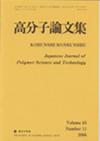Alternative copolymerization of carbon dioxide and epichlorohydrin, and successive quaternization of obtained aliphatic polycarbonate
Q3 Materials Science
引用次数: 0
Abstract
Alternating copolymerization of carbon dioxide and epichlorohydrin, followed by quaternization of obtained polymers with pyridine was carried out to give alternating copolymers containing pyridinium chloride groups, of which ionic conductivity was investigated. The alternating copolymer, poly [ 4 -( chloromethyl )- 1,3 - dioxolan - 2 - one ] ( poly ( ECH - alt - CO 2 )) ( M w = 17,000 ) , was formed when zinc glutarate was employed as a catalyst. Degradation was dominant when 1 - methylimidazole or n - butyldimethylamine were employed for quaternization. In the case of pyridine, the cationized polycarbonate was formed with moderate selectivity in the early period of quaternization. Volume resistivity of the partially cationized ( 11.6mol% ) polycarbonate was 1.87 × 10 7 ³ cm and much lower than that of the non - ionic poly ( ECH - alt - CO 2 ) ( 1.21 × 10 14 ³ cm ) .二氧化碳与环氧氯丙烷的交替共聚,以及所得脂肪族聚碳酸酯的连续季铵化反应
将二氧化碳与环氧氯丙烷交替共聚,然后与吡啶进行季铵化反应,得到含氯化吡啶基团的交替共聚物,并对其离子电导率进行了研究。以戊二酸锌为催化剂,生成了聚[4 -(氯甲基)- 1,3 -二恶兰- 2 - 1](聚(ECH - alt - CO 2)) (M w = 17000)的交替共聚物。当采用1 -甲基咪唑或正丁基二甲胺进行季铵化反应时,降解是主要的。以吡啶为原料,在季铵化初期形成的阳离子聚碳酸酯具有中等的选择性。部分阳离子化聚碳酸酯(11.6mol%)的体积电阻率为1.87 × 10 7³cm,远低于非离子聚碳酸酯(ECH - alt - co2)的体积电阻率(1.21 × 10 14³cm)。
本文章由计算机程序翻译,如有差异,请以英文原文为准。
求助全文
约1分钟内获得全文
求助全文

 求助内容:
求助内容: 应助结果提醒方式:
应助结果提醒方式:


